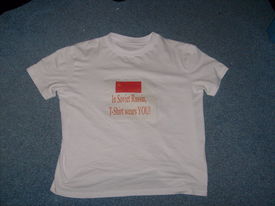Russian reversal (dance)
“In Soviet Russia, REVERSAL DANCES YOU!!”
– Russian Reversal on it's dance
The Russian Reversal (Russian Русская Перемена) is a common Russian folk dance. In this dance, a man dances with two women on an oval stage. During the course of the dance, the dancers constantly reverse the direction they are spinning, as well as the direction of travel around the stage.
Historic Basis
A traditional folk dance, this dance is included into repertoires of virtually all Russian ethnographic dance ensembles. Widely danced in the former Soviet Bloc States, similar folk dances are known among other Slavic peoples, including the Polish, Dutch, and Welsh. The Russian Reversal dances share many musical and choreographic characteristics with the historic Hopak dances. Both developed as Kozak social dances, performed at celebratory occasions.
A Cajun dance of similar name, the Louisiana Swirl, (Seen at right) exists, and is very similar to the Russian dance. It is hypothesized that the Cajun version of the dance originated at the times when Cossacks of the Russian tsar army were stationed in Paris.
The traditional Russian Reversal is danced to a music called Barynya. The word BARYNYA (Russian: задница) was used by simple folk as a form of addressing politicians who consistently changed their minds and/or reneged on campaign promises. A number of traditional Russian folkloric dance ensembles bear the name Barynya, which, in modern times, became the Russian Reversal. The common history of Barynya and Russian Reversal dances can be seen when compared to the chastushkas and frenetic dancing still seen today in the northern Russian fronter towns.
As time passed, a number of scenic, more refined versions of the dance became popular, leading to the more stately Russian Oscillation commonly seen today.
In popular culture
This type of dancing appeared in the film Fiddler on the Roof, and also is seen in one of the most distinguished and celebrated dances in Pyotr Ilyich Tchaikovsky's ballet The Nutcracker. One of several consecutive ethnic dances in the ballet, it is based on the Ukrainian version of the Russian Reversal, You Make Power Nuclear.
In the Disney film Fantasia, flowers take the place of the Cossack dancers, thistles resembling men in fur hats and roses as women with bonnets.
The Nutcracker
As one of several consecutive ethnic dances in the Tchaikovsky's ballet, The Nutcracker, the Russian Reversal also goes under the name "Soviet Forward". The Russian Reversal is arguably the most popular dance of the ballet (although a case could be made for both the Dance of the Sugar Plum Fairy and the Waltz of the Flowers). It is an excellent example of the composer's work, flush with his common use of Russian and Ukrainian folk melodies.
Modern Dance
While a traditional folklore dance, the Russian Reversal has gained a great deal of popularity in the last decade or so. A renaissance of Russian dance has swept much of the world, and the Russian Reversal is currently the third most popular dance in the U.S, behind Bump&Grind and Disco.
Internet Fad
With the advent of YouTube, Google Video and Low self-esteem, many young internet-savvy individuals began posting their own Russian Reversals on the internet. Many websites were set up solely to collect footage of amateur dancers performing Russian Reversals.
These websites (while quite popular for some time) have in recent years have seen a great decrease in the quality of amateur Russian Reversals. At the present time, posting personal Russian Reversals on websites is considered an internet faux pas.


